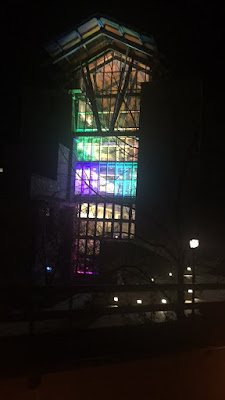This painting seemed very familiar to me. I then realized it reminded me of the classic windows background. They look nearly identical!
The two pictures were so alike I decided it would be interesting to compare the two. I printed each of them out and cut them into four strips each. I laid them across the center of the paper with them eventually staggering off. This leads your eye from the left side of the picture to the right side. I then added some green pictures I cut out from magazines at the bottom left corner and added some sky pictures to the top left of the picture, creating a type of heaviness on the left side of the picture and eventually becoming softer the most your eye glides to the right side of the picture. After seeing my finished product I decided it needed something to unify it a little more, so, I decided to add clouds that go over both strips of pictures. The clouds use implied lines like Renoir and created a uniformity between the two similar but different pictures. I believe that although Renoir would classify this picture as very different from his usual work, he can still see some similarities between what I did and what he is used to doing. I believe this is a modern take on his very impressionist work in that I used very sharp lines and implied lines within my piece.
I really enjoyed being in SA224. I learned a lot about how to describe an artists work and to not only look at the literal meaning but also a deeper meaning. Each piece of art is different and can hold their own message. One thing I will defiantly be using in the future is the skills I learned when we did Photoshop. I enjoy manipulating art and changing it through Photoshop. My only advice to make this class better is to have more time in class to work on projects. Overall, I really enjoyed learning more about art and how to interpret it.
















